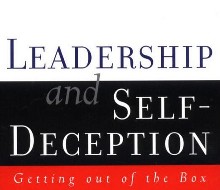 Once in a blue moon—no, make that once in a chartreuse moon with auburn highlights—there comes a book about leadership that is useful as more than bookshelf filler. Leadership and Self-Deception by The Arbinger Institute is one such book, and I recommend you snap it up.
Once in a blue moon—no, make that once in a chartreuse moon with auburn highlights—there comes a book about leadership that is useful as more than bookshelf filler. Leadership and Self-Deception by The Arbinger Institute is one such book, and I recommend you snap it up.
This book goes right to the core of what causes the most chaos and lack of results in organizations and families: self-deception. Published in 2002, Leadership and Self-Deception holds up a mirror to those ugly attitudes we hold against others that are underneath the very behaviors we ourselves display. Put simply, what you do doesn’t matter as much as why you do it.
People will not follow you if your motives are selfish. The problem is, we often don’t know that our motivation is flawed. We deceive ourselves into thinking that we’re doing the right thing for the right reason when we’re really mired in selfishness. It becomes such an ingrained habit that it’s hard to break free.
Unfortunately, we are never completely cured of the disease of self-deception. Every human being lives in self-deception a fair amount of time. We put our needs ahead of the needs of others and treat people as objects—chess pieces on the chess board. Is it any wonder that employee disengagement scores are over 60 percent?
Perhaps the reason the television show The Office is so popular is that Michael, the boss from hell, is the poster child for self-deception. No matter how many communications courses you give to a person who is self-deceived, it always comes out sideways.
Once we get ourselves out of self-service and into the profound service of others, amazing things happen. People will follow such a leader, gladly and with all pistons firing.
I ask our CEOs to reread this book every year, as I do, to hopefully wince less and become less self-deceived and better able to inspire lasting and positive change.

